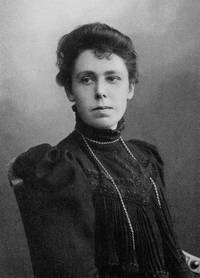


She found no fulfillment in her work as a private science teacher, so Margarete von Wrangell began studying chemistry and botany at the age of 26. As head of the Institute for Plant Nutrition in Hohenheim, she caused a worldwide sensation with studies on phosphorus fertilization.
Margarete Baroness von Wrangell was born on January 7, 1877 in Moscow. She came from a long-established Baltic noble family and grew up in Moscow and in Reval, Estonia, now Tallinn. After attending a German-speaking girls' school in Reval and her teacher's examination, which she passed with distinction in 1894, she gave private science lessons for several years. But she did not find fulfillment in it. In a letter to a friend, she wrote: "I'm miserable. I can't get along in this twisted world. […] I was so tired of everything. […] Is there really nothing exciting, alive, worth living coming up?”
At the age of 26, after attending a botany course at the Royal University of Greifswald, von Wrangell decided to study natural sciences. She enrolled in 1904 as one of the few women to study botany and chemistry at the Eberhard Karls University in Tübingen. In the Kingdom of Württemberg, to which Tübingen belonged at the time, women had been allowed to attend universities since 1904. This made Margarete von Wrangell one of the first female students. She received her doctorate in organic chemistry in Tübingen in 1909, summa cum laude. The title of her doctoral thesis was "Isomeric phenomena in formylglutaconic acid ester and its bromine derivatives". She then found employment at the Agricultural Experimental Station in Dorpat, now Tartu, the second largest city in Estonia after Tallinn.
von Wrangell spent research stays in 1910 with William Ramsey (1852-1916), winner of the Nobel Prize in Chemistry, at University College in London (1910) and in 1912 with Marie Curie (1867-1934), who won the Nobel Prize twice, at the Sorbonne in Paris. At the end of 1912 she took over the management of the experimental station of the Estonian Agricultural Society in Reval. When the station was forced to close during the October 1917 Revolution, von Wrangell was imprisoned for several weeks for refusing to hand over control of the station to the revolutionaries. After being liberated by German troops, she left the Baltics forever.
In the summer of 1918 von Wrangell had the opportunity to work at the Hohenheim Agricultural Research Station near Stuttgart. There she was entrusted with the management of the newly founded Institute for Plant Nutrition as early as 1920. Her habilitation took place in the same year with a scientific work on "Phosphoric acid uptake and soil reaction". The position as head of the institute was initially advertised as an associate professor, but on January 1, 1923, despite considerable resistance from the male faculty members, von Wrangell was appointed full professor of plant nutrition at the Hohenheim Agricultural College. She was the first full professor in Germany.
Von Wrangell acquired a considerable scientific reputation in a relatively short time. Personally, however, she was considered dominant to domineering. This was not exactly conducive to a collegial relationship with the other university teachers in Hohenheim, as she expressed in a letter to her mother: "I have a lot of struggles in my job. I am the first full female professor in Germany. I have also been publicly recognized by some scientific greats. This has earned me the enmity of many; but my institute is a creation that will remain of lasting value and benefit. [...] Anyway, I know what I'm fighting for."
Through her studies on phosphorus fertilization, some of which triggered a heated argument, von Wrangell became known as a scientist far beyond her area of expertise. Much attention was also paid to her function as editor of the practice-oriented book "Die Düngerlehre" by her Soviet colleague Nikolajewitsch Prjanischnikov (1865-1948), which was published in 1923. In 1928 von Wrangell married her cousin and childhood friend Prince Vladimir Andronikov. From then on she was allowed to call herself Princess Andronikov.
Von Wrangell described her intimate relationship with plants as follows: “I lived with the plants. I put my ear to the soil and it seemed to me that the plants were happy to be able to tell something about the secrets of growth.” During her time as head of the Hohenheim Institute, 42 scientific papers were published and 15 dissertations completed. She managed the institute, which included laboratories and a test field, during financially difficult times until her early death on March 21, 1932. Margarete von Wrangell died in Hohenheim at the age of just 55 from chronic kidney disease.
When the University of Hohenheim celebrated its 200th anniversary in January 2018, von Wrangell recognized her as one of the most important women in the history of the university. Two state funding initiatives also bear her name: a foundation set up by the state government of North Rhine-Westphalia in 1992 and a habilitation program for women launched by the Baden-Württemberg Ministry of Science in 1997, which has already funded over 200 female scientists. As a result, the proportion of women at universities in Baden-Württemberg has increased significantly in recent years.
a notice
The texts published in this series do not claim to be scientific publications. Authors and other people involved are not experts in the history of science. The purpose of the series is to introduce the mostly unknown women chemists and to remind you of the well-known women chemists. We encourage readers who want to know more to study academic Literature on the women featured. In some cases there are detailed chemical-historical works.
authors
Prof. Dr. Eberhard Ehlers
Prof. Dr. Heribert Offermanns
Editorial processing
Dr Uta Neubauer
project management
Dr Karin J. Schmitz (GDCh public relations)
The authors are responsible for the content of the biographies.
The content presented on these pages has been carefully compiled. However, the authors, Editorial staff and publishers assume no responsibility or liability for the completeness and correctness of the content or for typographical errors.
Photo: Wikimedia Commons, Unknown author, Margarete von Wrangell , public domain
back to overview biographies of female chemists
back to publications
This page has been machine translated. If you have any feedback or comments please feel free to contact us. 
last modified: 30.03.2023 13:59 H from Translator